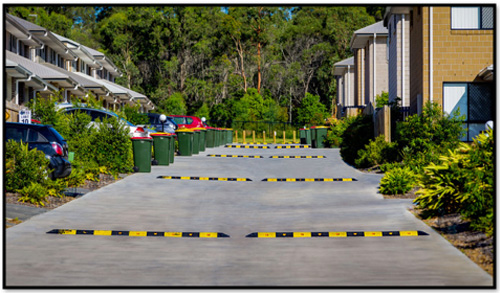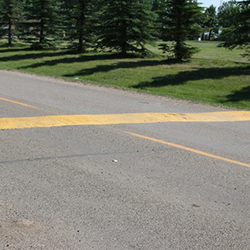Speed bumps play a crucial role in ensuring pedestrian safety by reducing vehicle speeds and enhancing crosswalk safety. They are particularly effective in residential areas, school zones, and parking lots. However, designing and implementing effective speed bumps requires careful consideration of various factors such as height and width requirements, placement and spacing, materials and construction, and visibility and signage. While speed bumps are effective in improving pedestrian safety, they can also impact traffic flow and potentially cause congestion. Therefore, it is important to strike a balance between safety and traffic efficiency. Community engagement is crucial in the implementation of speed bumps, including gathering public input and feedback, collaborating with local authorities, addressing concerns and opposition, and monitoring and evaluation.
Key Takeaways
- Speed bumps are essential for reducing vehicle speeds in residential areas and enhancing crosswalk safety.
- They play a crucial role in preventing accidents in school zones and improving pedestrian safety in parking lots.
- Design considerations for effective speed bumps include height and width requirements, placement and spacing, materials and construction, and visibility and signage.
- Speed bumps can impact traffic flow and potentially cause congestion, so it is important to consider alternative traffic calming measures.
- Community engagement is crucial in the implementation of speed bumps, including gathering public input and feedback, collaborating with local authorities, addressing concerns and opposition, and monitoring and evaluation.
The Importance of Speed Bumps in Pedestrian Safety
Reducing Vehicle Speeds in Residential Areas
Speed bumps are an effective tool for reducing vehicle speeds in residential areas.
Excessive speeding in these neighborhoods can pose a significant risk to pedestrians, especially children and the elderly. By installing speed bumps, drivers are forced to slow down, creating a safer environment for everyone.
In addition to reducing speeds, speed bumps also serve as a visual reminder for drivers to be cautious and aware of their surroundings. This can help prevent accidents and promote a sense of shared responsibility for pedestrian safety.
To further emphasize the importance of reducing vehicle speeds in residential areas, here are some key points:
- Speed bumps have been shown to reduce vehicle speeds by an average of 10-20 mph.
- Studies have found that neighborhoods with speed bumps experience fewer accidents and injuries.
- Speed bumps can help deter cut-through traffic, making residential streets less attractive to drivers seeking shortcuts.
Tip: When implementing speed bumps, it is important to consider the appropriate height and width to ensure effectiveness without causing discomfort to drivers.
Enhancing Crosswalk Safety
Enhancing crosswalk safety is a crucial aspect of pedestrian safety. One effective measure to improve crosswalk safety is the installation of
high-visibility crosswalk markings. These markings are painted on the road surface and are designed to alert drivers to the presence of a crosswalk. They are typically painted with bold white lines and may include additional features such as crosswalk signs or flashing lights.
Another important consideration for enhancing crosswalk safety is the implementation of
pedestrian-activated signals. These signals allow pedestrians to activate a flashing light or audible signal to alert drivers of their intention to cross the road. Pedestrian-activated signals are particularly beneficial at busy intersections or locations with high pedestrian traffic.
In addition to these measures, it is essential to ensure proper
maintenance of crosswalks. Regular inspection and repair of faded or damaged crosswalk markings, as well as proper lighting, are crucial for maintaining crosswalk safety.
To summarize, enhancing crosswalk safety involves the installation of high-visibility crosswalk markings, the implementation of pedestrian-activated signals, and the maintenance of crosswalk infrastructure.
Preventing Accidents in School Zones
Speed bumps play a crucial role in preventing accidents in school zones. These areas are particularly vulnerable to accidents due to the presence of young children who may not always be aware of traffic dangers. By installing speed bumps in school zones, vehicle speeds can be reduced, creating a safer environment for both pedestrians and drivers.
Implementing speed bumps in school zones can also serve as a visual reminder for drivers to exercise caution and be alert for children crossing the road. This can help to enhance crosswalk safety and reduce the risk of accidents.
In addition to speed bumps, other measures such as clear signage and designated crossing areas should be implemented to further improve pedestrian safety in school zones.
It is important for local authorities and school administrations to collaborate in identifying high-risk areas within school zones and strategically placing speed bumps to effectively prevent accidents. Regular monitoring and evaluation of the impact of speed bumps on accident rates can also help in identifying areas for improvement and ensuring the ongoing safety of school zones.
Improving Pedestrian Safety in Parking Lots
Parking lots are often busy and chaotic, posing significant risks to pedestrians. To enhance pedestrian safety in parking lots, several measures can be implemented:
- Clear signage and markings: Clearly marked crosswalks, pedestrian pathways, and designated parking areas can help guide pedestrians and drivers and reduce the risk of accidents.
- Speed bumps: Strategically placed speed bumps can effectively slow down vehicles, reducing the likelihood of collisions with pedestrians. These speed bumps should be designed with the appropriate height and width to ensure they are effective without causing discomfort to drivers.
- Lighting: Well-lit parking lots can improve visibility and deter criminal activity, creating a safer environment for pedestrians.
- Security patrols: Regular patrols by security personnel can help deter crime and provide assistance to pedestrians in need.
- Surveillance cameras: Installing surveillance cameras can help monitor parking lot activities and provide evidence in case of incidents or accidents.
- Education and awareness campaigns: Promoting pedestrian safety through educational campaigns can help raise awareness among both pedestrians and drivers, encouraging responsible behavior and reducing the risk of accidents.
Design Considerations for Effective Speed Bumps
Height and Width Requirements
When it comes to the design of speed bumps, there are several important considerations to keep in mind. These considerations ensure that speed bumps are effective in slowing down vehicles and improving pedestrian safety.
Height and Width Requirements: One of the key factors to consider is the height and width of the speed bumps. According to industry standards, the height of speed bumps should be between 3 to 4 inches, while the width should be around 12 to 14 feet. These dimensions are crucial in order to effectively reduce vehicle speeds without causing discomfort or damage to vehicles.
To ensure compliance with these requirements, municipalities and transportation departments often conduct regular inspections and maintenance of speed bumps.
It is important to note that the specific height and width requirements may vary depending on the location and purpose of the speed bumps. Local regulations and guidelines should be consulted for accurate specifications.
Placement and Spacing
When it comes to the placement and spacing of speed bumps, careful consideration is essential to ensure their effectiveness in promoting pedestrian safety.
Proper placement is crucial to ensure that vehicles are forced to slow down in areas where pedestrians are most vulnerable, such as near crosswalks, schools, and residential areas.
Spacing between speed bumps is also an important factor to consider.
Adequate spacing allows drivers to regain their speed between bumps, preventing excessive braking and potential traffic congestion. However, spacing should not be too wide, as it may diminish the overall effectiveness of the speed bumps in reducing vehicle speeds.
To strike the right balance, local authorities and traffic engineers should conduct thorough assessments of the road conditions, traffic patterns, and pedestrian activity in order to determine the optimal placement and spacing of speed bumps in each specific location.
In addition, it is important to ensure that speed bumps are clearly marked with appropriate signage and road markings to alert drivers in advance and minimize the risk of accidents.
Materials and Construction
When it comes to the materials and construction of speed bumps, several factors need to be considered.
Durability is a key aspect, as speed bumps should be able to withstand the weight and impact of vehicles over time. Common materials used for speed bumps include
rubber,
asphalt, and
concrete.
Another important consideration is
installation. Speed bumps should be properly installed to ensure their effectiveness and longevity. This includes proper
anchoring to the ground and ensuring a
smooth transition between the road surface and the speed bump.
In terms of construction, speed bumps can be either
pre-fabricated or
constructed on-site. Pre-fabricated speed bumps are often made of rubber and can be easily installed, while on-site construction allows for customization and integration with the existing road infrastructure.
It is important to note that the specific materials and construction methods may vary depending on local regulations and road conditions.
- Rubber: Provides a cushioning effect and is less likely to cause damage to vehicles.
- Asphalt: Offers a smooth surface and can be easily integrated into the road.
- Concrete: Provides durability and can withstand heavy traffic.
Tip: Regular maintenance and inspection of speed bumps is essential to ensure their continued effectiveness and safety.
Visibility and Signage
When it comes to
speed bumps,
visibility and
signage are crucial for their effectiveness. Proper visibility ensures that drivers are aware of the presence of speed bumps in advance, giving them enough time to slow down. Signage, such as warning signs and pavement markings, further reinforces the presence of speed bumps and alerts drivers to reduce their speed.
To enhance visibility, speed bumps should be painted with bright colors that contrast with the surrounding pavement. This helps drivers easily spot the speed bumps, especially during low-light conditions or in areas with heavy traffic. Additionally, reflective materials can be used to make the speed bumps more visible at night.
In terms of signage, clear and easily understandable signs should be placed before the speed bumps to provide drivers with a clear warning. The signs should include symbols or words that indicate the presence of speed bumps and the recommended speed limit. This helps drivers anticipate the need to slow down and ensures pedestrian safety.
To summarize, ensuring proper visibility and signage for speed bumps is essential in promoting pedestrian safety and reducing vehicle speeds.
The Impact of Speed Bumps on Traffic Flow
Effect on Vehicle Speed
Speed bumps are highly effective in reducing vehicle speeds in areas where pedestrian safety is a concern. Studies have shown that the presence of speed bumps can significantly decrease the average speed of vehicles, especially in residential areas and school zones. This reduction in speed is crucial in preventing accidents and improving pedestrian safety.
Implementing speed bumps can also serve as a visual reminder for drivers to slow down and be more cautious. The physical presence of speed bumps forces drivers to reduce their speed, making it safer for pedestrians to cross the road or navigate through parking lots.
It is important to note that while speed bumps are effective in reducing vehicle speeds, they may also have an impact on traffic flow. In some cases, speed bumps can cause traffic congestion, especially during peak hours. Therefore, it is essential to carefully consider the placement and spacing of speed bumps to minimize any potential negative effects on traffic flow.
To ensure the effectiveness of speed bumps, proper visibility and signage are crucial. Clear and visible markings, along with appropriate signage, can help drivers anticipate the presence of speed bumps and adjust their speed accordingly.
In summary, speed bumps play a vital role in reducing vehicle speeds and improving pedestrian safety. However, their implementation should be carefully planned to balance safety concerns with potential impacts on traffic flow.
Potential Traffic Congestion
Speed bumps have been shown to effectively reduce vehicle speeds in residential areas, enhancing pedestrian safety. However, one potential concern with the implementation of speed bumps is the possibility of increased traffic congestion.
To address this issue, it is important to carefully consider the placement and spacing of speed bumps. Properly spaced speed bumps can help maintain a smooth flow of traffic while still effectively slowing down vehicles. Additionally, alternative traffic calming measures such as roundabouts or traffic circles can be considered in areas where speed bumps may cause significant congestion.
It is crucial to strike a balance between ensuring pedestrian safety and minimizing traffic disruptions. By implementing well-designed speed bumps and considering alternative traffic calming measures, communities can effectively manage potential traffic congestion while prioritizing pedestrian safety.
Alternative Traffic Calming Measures
In addition to speed bumps, there are several other
traffic calming measures that can be implemented to improve pedestrian safety. These measures include:
- Traffic circles: Also known as roundabouts, traffic circles can help reduce vehicle speeds and improve traffic flow at intersections.
- Chicanes: These are designed to create a zigzag pattern on the road, forcing drivers to slow down and navigate through a series of curves.
- Raised crosswalks: Similar to speed bumps, raised crosswalks are elevated sections of the road that encourage drivers to slow down when approaching pedestrian crossings.
Tip: When considering alternative traffic calming measures, it is important to assess their effectiveness in reducing vehicle speeds and improving pedestrian safety.
Balancing Safety and Traffic Efficiency
When implementing speed bumps as a traffic calming measure, it is crucial to strike a balance between ensuring pedestrian safety and maintaining traffic efficiency. While speed bumps effectively reduce vehicle speeds and enhance pedestrian safety, they can also lead to potential traffic congestion and delays.
To address this challenge, it is important to consider alternative traffic calming measures that can complement the use of speed bumps. These measures may include the installation of traffic signs, speed limit enforcement, and the implementation of traffic circles or roundabouts.
Table: Comparison of Traffic Calming Measures
| Measure |
Pros |
Cons |
| Speed Bumps |
Reduces vehicle speeds |
Potential traffic congestion |
| Traffic Signs |
Provides clear instructions |
Relies on driver compliance |
| Speed Limit Enforcement |
Encourages adherence to limits |
Requires enforcement efforts |
| Traffic Circles |
Promotes smooth traffic flow |
Requires space for installation |
Note: The table above provides a comparison of different traffic calming measures and their respective pros and cons.
In addition, community engagement plays a crucial role in the successful implementation of speed bumps. Gathering public input and feedback, collaborating with local authorities, and addressing concerns and opposition are essential steps in ensuring that the chosen traffic calming measures are well-received by the community.
Tip: Regular monitoring and evaluation of the effectiveness of speed bumps and other traffic calming measures can help identify areas for improvement and make necessary adjustments to strike the right balance between safety and traffic efficiency.
Community Engagement and Speed Bump Implementation
Gathering Public Input and Feedback
When gathering public input and feedback for speed bump implementation, it is important to create opportunities for community members to voice their opinions and concerns. This can be done through various methods, such as town hall meetings, surveys, or online platforms.
Engaging with the community in a transparent and inclusive manner helps build trust and ensures that the final decision reflects the needs and preferences of the residents.
To facilitate the collection and analysis of feedback, it can be helpful to use a structured approach. One way to do this is by implementing a
survey that allows individuals to provide their input on specific aspects of speed bump implementation, such as preferred locations or design considerations. This quantitative data can then be analyzed to identify common themes or patterns.
In addition to surveys, it is also important to consider qualitative feedback.
Listening to the concerns and suggestions of community members through open-ended questions or public forums can provide valuable insights that may not be captured by quantitative data alone.
Tip: When gathering public input and feedback, it is important to actively listen and acknowledge the concerns raised by community members. This helps foster a sense of ownership and collaboration, leading to a more successful implementation of speed bumps.
Collaborating with Local Authorities
Collaborating with local authorities is crucial for the successful implementation of speed bumps. It is important to establish open lines of communication and work together to address any concerns or issues that may arise. Local authorities can provide valuable insights and expertise in determining the most suitable locations for speed bumps and ensuring they comply with local regulations.
To facilitate collaboration, it is recommended to:
- Schedule meetings with local authorities to discuss the proposed speed bump locations and gather their input.
- Share relevant data and studies that support the need for speed bumps in specific areas.
- Seek feedback from local authorities on the design and placement of speed bumps.
Tip: Building a strong relationship with local authorities can help streamline the approval process and ensure the successful implementation of speed bumps.
Addressing Concerns and Opposition
When implementing speed bumps, it is important to address concerns and opposition from the community. By actively engaging with residents and local authorities, potential issues can be identified and solutions can be developed collaboratively. Some common concerns raised by residents include increased noise levels, potential damage to vehicles, and the impact on emergency response times.
To address these concerns, it is crucial to gather public input and feedback through surveys, town hall meetings, or online platforms. This allows residents to express their opinions and concerns, and provides an opportunity to educate them about the benefits of speed bumps in improving pedestrian safety.
Collaborating with local authorities is also essential in the implementation process. By working closely with traffic engineers and city officials, the design and placement of speed bumps can be optimized to minimize negative impacts while still achieving the desired safety outcomes.
Monitoring and evaluation are key components of addressing concerns and opposition. By regularly assessing the effectiveness of speed bumps and gathering feedback from the community, adjustments can be made to address any ongoing issues and ensure the continued success of the pedestrian safety measures.
Monitoring and Evaluation
Monitoring and evaluation are crucial components of any speed bump implementation project. It is important to regularly assess the effectiveness of speed bumps in improving pedestrian safety and addressing traffic concerns. This can be done through a combination of quantitative and qualitative data collection methods.
One approach is to conduct regular speed surveys to measure the impact of speed bumps on vehicle speeds. This data can help determine if the speed bumps are effectively reducing vehicle speeds in the designated areas.
In addition to speed surveys, gathering feedback from the community is essential. This can be done through surveys, public meetings, or online platforms. Listening to the concerns and experiences of pedestrians, drivers, and residents can provide valuable insights into the effectiveness of speed bumps and identify areas for improvement.
To ensure ongoing effectiveness, it is important to regularly evaluate the condition of speed bumps. This includes checking for any damage or wear and tear that may affect their performance. Maintenance and repairs should be carried out promptly to ensure the continued safety of pedestrians and drivers.
Monitoring and evaluation are key to ensuring that speed bumps are serving their intended purpose and making a positive impact on pedestrian safety.
Conclusion
In conclusion, speed bumps play a crucial role in enhancing pedestrian safety. They effectively slow down vehicles, reducing the risk of accidents and creating a safer environment for pedestrians. The presence of speed bumps serves as a visual reminder for drivers to exercise caution and be mindful of their surroundings. Additionally, speed bumps encourage drivers to adhere to speed limits, further minimizing the potential for collisions. Overall, the implementation of speed bumps is a valuable measure in promoting pedestrian safety and should be considered in areas with high foot traffic.
Frequently Asked Questions
What is the purpose of speed bumps?
Speed bumps are designed to slow down vehicle speeds in order to enhance pedestrian safety and reduce the risk of accidents.
Where are speed bumps commonly installed?
Speed bumps are commonly installed in residential areas, school zones, parking lots, and areas with high pedestrian activity.
Do speed bumps cause damage to vehicles?
When designed and installed properly, speed bumps should not cause significant damage to vehicles. However, excessive speed or improper design can potentially cause damage.
Do speed bumps increase traffic congestion?
Speed bumps can potentially cause slight traffic congestion, especially during peak hours. However, their primary purpose is to enhance pedestrian safety.
Are there alternative traffic calming measures to speed bumps?
Yes, there are alternative traffic calming measures such as speed humps, roundabouts, speed cameras, and increased enforcement of traffic laws.
How can the community provide input on speed bump implementation?
The community can provide input on speed bump implementation through public meetings, surveys, and collaboration with local authorities.






